( – promoted by navajo)
At the height of the Classic Period (200 CE to 900 CE), the Maya population numbered several million people living in 60 kingdoms in the greater Yucatan area of Mexico. The Maya built large cities which were supported by the agricultural surpluses from the villages and towns in the surrounding countryside.

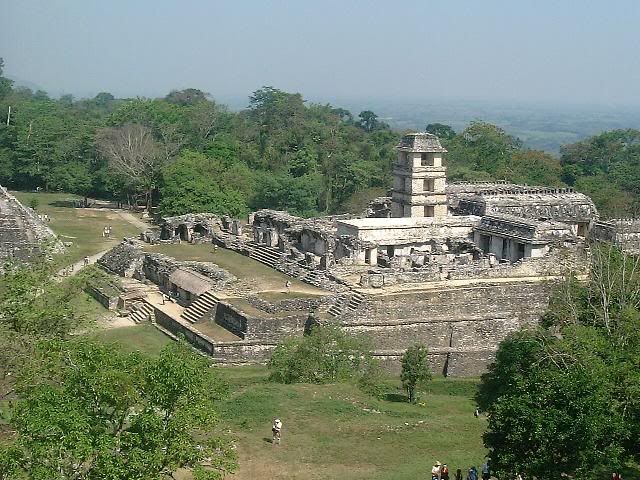
The Maya site of Palenque is shown above.
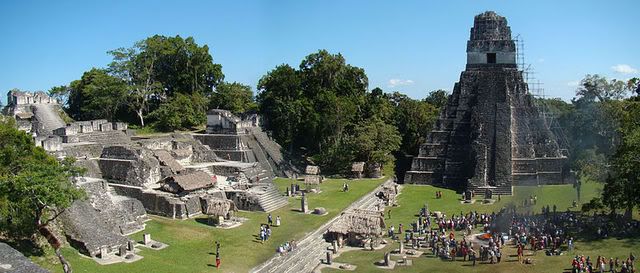
The Maya site of Tikal is shown above.
Maya kings were divine shamans who kept the world in balance through the power of their ritual performances. In this way they brought prosperity to their domains. Kings inherited their position through the male line and were thus able to trace their lineage back to a founding ancestor.
Maya kings were the conduit of the sacred, the path of communication to the Otherworld, and the means of contacting the dead. The king had the knowledge of when to plant and when to harvest as well as the knowledge of illness and health. The king would read in the heavens when to go to war and when to maintain the peace. Through his knowledge, the king would negotiate trade agreements which were advantageous for his people.
Typical of kingdoms in other parts of the world, Maya kings faced the challenges of internal intrigues and wars with other kingdoms. It was not uncommon for a Maya king to end his life by being taken captive in a war that he was too old to fight.
Maya country was linked together by a series of roads which facilitated foot travel, and by rivers which acted as highways for canoes. Unlike the European civilizations, the Maya did not have domestic animals which could be used as beasts of burden. Therefore the canoe was the most important form of travel. Maya trade networks linked together the communities within each kingdom as well as linking the kingdoms with the outside world. The Maya traded as far north as the southern part of the United States and as far south as South America.
The Maya used several precious commodities for money: carved and polished greenstone beads, red spiny oyster shell beads, cacao beans, lengths of cotton cloth, and measures of sea salt. The values of these various commodities were probably set by the king.
The Maya lived, and continue to live, in a tropical area which can receive as much as 150 inches of rain per year. The problem, however, is that there is often too much water during the rainy season and not enough during the dry season. More than 2,000 years ago Maya engineers began to tackle two problems: (1) how to store water for the dry times, and (2) how to make wet, fertile swampland suitable for farming. As a result, the Maya built reservoirs and massive, complicated canal systems. Maya buildings often contained great cisterns for holding the rain water.
For their fields, the Maya excavated the muck from the swamp to create a system of raised fields and canals. This bottom mud was loaded with nutrients from fish excretions and provided fertilizer for the fields which resulted in two or three crops per year. In addition, the fields were adjacent to steady supplies of waters. To reduce the evaporation of the water in the canals, the Maya planted waterlilies and other plants. These plants, in turn, helped feed the fish in the canals. Overall, it was a delicate system which provided enormous productivity.
Many of the fields surrounding the Maya cities were owned by patrilineal family groups. Some of the fields were maintained as royal farms which used tribute labor.
The Maya were a literate people: their writing was capable of capturing all of the nuances of sound, meaning, and grammatical structure of the Maya languages. The Maya wrote by carving on stone, engraving jade, inscribing shell, and incising bone. In addition, they had accordion-folded books which were made from beaten bark paper surfaced with a thin layer of plaster. In their writings the Maya recorded their history, their genealogies, their views of the world, their mythology, and records of trading and tribute.
At one time, the Maya libraries held thousands of volumes of their books. These included literature and poetry as well as histories and the details of their rituals Feeling that the Maya books were the works of Satan, the Catholic priests who accompanied the Spanish invasion of the continent ordered them to be destroyed. Today, only four books are left and all of these are calendar almanacs for the timing of rituals.
In addition to books, the Maya also carved their writings in stone, known as stellae. Numerous examples of this type of writing, which often commemorate kings and royalty, are found in the ancient Maya cities such as Tikal, Copan, Palenque, Bonampak, and Chichén Itzá.
Maya counting (including mathematics and the Maya calendar) is based on units of twenty. From the Maya perspective, their counting is based on the full person, both fingers and toes. This is called a vigesimal counting system. In written Maya, a dot represents 1 and a bar represents 5. Numbers from 1 to 19 are represented by combinations of dots and bars. The largest number represented in this way is 19, consisting of three bars and four dots. For numbers great than 19, the Maya use a place value number system similar to that used by Europeans.

While Europeans mark the passage of time on ten-based intervals – decades, centuries, millenium – the Maya calendar uses 20-year cycles: katuns which mark 20 years and baktuns which mark 400 years (20 times 20).
The Maya viewed the world as being made up of three domains: the starry arch of heaven, the stony middleworld of the earth, and the dark waters of the underworld below.
The four cardinal directions provided the fundamental grid for both the Maya communities and the surface of the earth. The most important direction was east which was associated with the color red. If today’s maps were drawn by Maya cartographers, east would be shown at the top of the page. North, associated with the cool rains, is represented by the color white. West, the dying place of the sun, was represented by the color black. South was associated with the color yellow and was considered the right-hand of the sun.
The four cardinal directions were seen in relationship to the center which was represented by the color blue-green. Running through this center, the Maya envisioned an axis called Wacah Chan which was symbolized as a tree with its roots in the underworld and its branches soaring into the heavenly area above. The world of the human beings was connected to the Otherworld through the Wacah Chan. The Wacah Chan did not exist at a specific geographic place, but could be materialized through ritual at any point in the natural or human-made landscape.
There were two representations of the Wacah Chan: the king who brought it into existence and the World Tree. Through bloodletting rituals the king would bring the World Tree into existence and in this way open the doorway to the Otherworld.
Bloodletting was an act of piety which was used in all rituals from the birth of a child to the burying of the dead. Bloodletting could range from the shedding of a few drops of blood to mutilation which generated a copious flow of blood. While blood could be drawn from any part of the body, the most sacred sources of blood were the tongue for both males and females and the penis for males. Among men, the penis would be pierced several times with an obsidian razor and then long strands of bark paper pulled through the wounds. After piercing the penis, men would whirl in a dance to draw the blood out onto the long streamers tied to their members.
An important part of the bloodletting rite was the obsidian knife. Obsidian is a form of volcanic glass which could be made into long, thin, razor-sharp blades which were unsurpassed in their ability to make clean, quick wounds. As obsidian was invaluable in the bloodletting rituals, the supply of obsidian was controlled by the king.
Royal women would pierce their tongues using a sting-ray spine. Then a cord would be threaded through the wound. The blood would then saturate the paper lining a bowl which was held at the chest.
Some of the blood-soaked papers from both the tongue-piercings and penis-piercings would be burned in a censor along with offerings of corn, rubber, and tree resin.
The vision quest was also a central act of the Maya world. Through the vision quest, ancestors and gods could be enticed to communicate with human beings.
Another important part of Maya life was the ballgame which was played in a large courtyard. Ballgames were played for many reasons. Often the game was played between friends or professionals for sport and/or wagering. At other times, the game was a ritual in which captives were forced to play. In these games, the losing team was usually executed, sometimes by beheading and sometimes by binding each player into a ball-like form and hurling them down the temple steps.
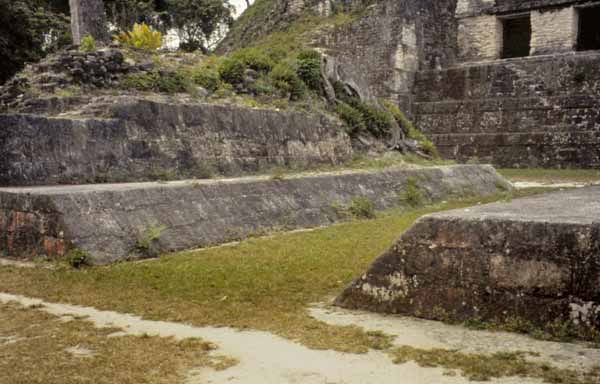
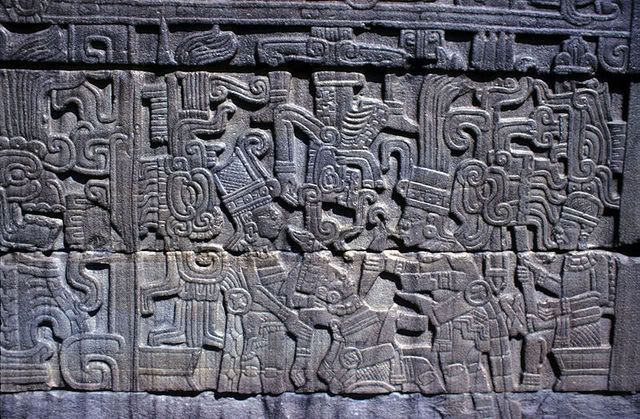
The Maya often used crystals in curing and in divining. The power of the crystals came from the earth and crystals which were found in caves were considered to be especially powerful.
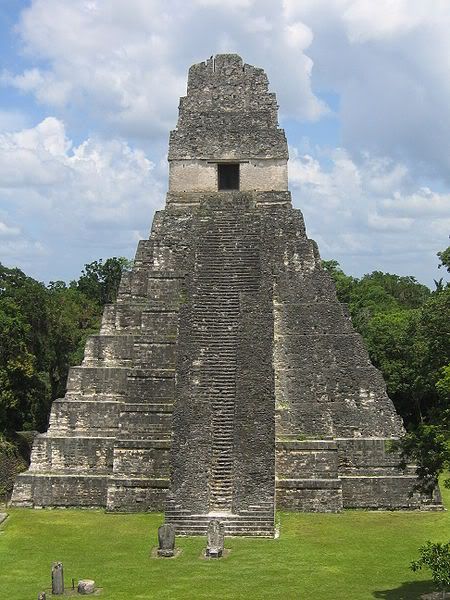
The temple at Tikal is shown above.
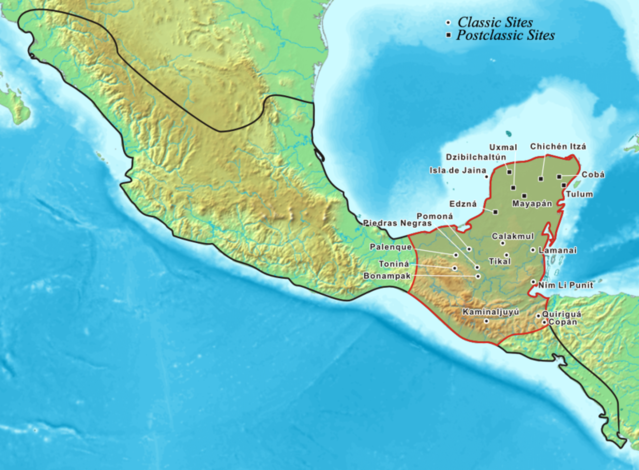
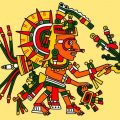
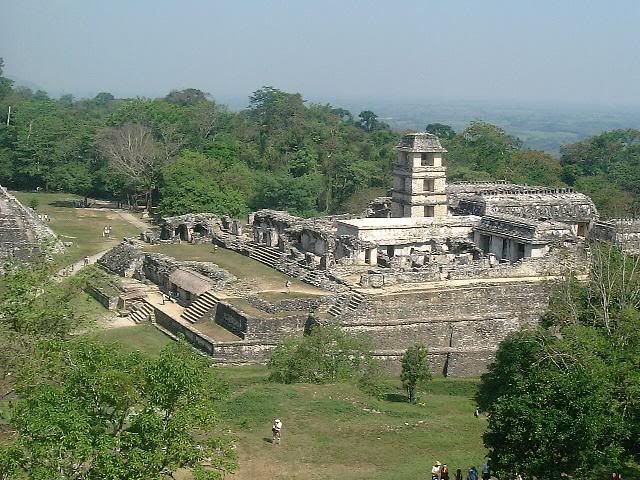
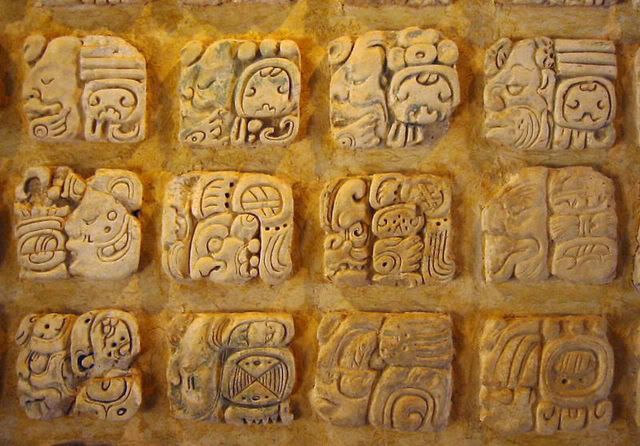
Leave a Reply